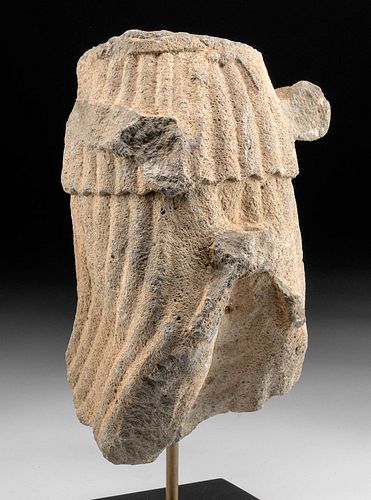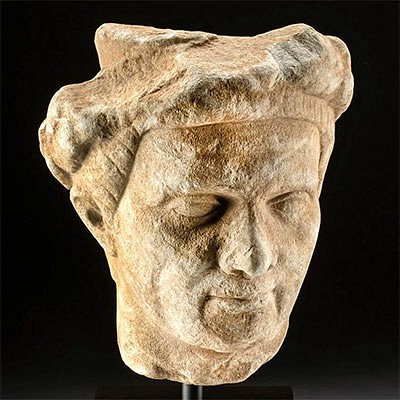Roman Basalt Lower Body of a Female
Lot 32
About Seller
Artemis Fine Arts
686 S Taylor Ave, Ste 106
Louisville, CO 80027
United States
Selling antiquities, ancient and ethnographic art online since 1993, Artemis Gallery specializes in Classical Antiquities (Egyptian, Greek, Roman, Near Eastern), Asian, Pre-Columbian, African / Tribal / Oceanographic art. Our extensive inventory includes pottery, stone, metal, wood, glass and textil...Read more
Estimate:
$1,200 - $1,800
Absentee vs Live bid
Two ways to bid:
- Leave a max absentee bid and the platform will bid on your behalf up to your maximum bid during the live auction.
- Bid live during the auction and your bids will be submitted real-time to the auctioneer.
Bid Increments
| Price | Bid Increment |
|---|---|
| $0 | $25 |
| $300 | $50 |
| $1,000 | $100 |
| $2,000 | $250 |
| $5,000 | $500 |
| $10,000 | $1,000 |
| $20,000 | $2,500 |
| $50,000 | $5,000 |
| $100,000 | $10,000 |
| $200,000 | $20,000 |
About Auction
By Artemis Fine Arts
Jun 1, 2023
Set Reminder
2023-06-01 10:00:00
2023-06-01 10:00:00
America/New_York
Bidsquare
Bidsquare : Ancient | Asian | Ethno | Native American Art
https://www.bidsquare.com/auctions/artemis-gallery/ancient-asian-ethno-native-american-art-12905
Featuring classical antiquities, ancient, and ethnographic art from cultures encompassing the globe. Egyptian, Greek, Roman, Near Eastern, Asian, Pre-Columbian, Native American, African / Tribal, Oceanic, Spanish Colonial, Fossils, more! All legally acquired, legal to sell. Satisfaction guaranteed. Artemis Fine Arts info@artemisgallery.com
Featuring classical antiquities, ancient, and ethnographic art from cultures encompassing the globe. Egyptian, Greek, Roman, Near Eastern, Asian, Pre-Columbian, Native American, African / Tribal, Oceanic, Spanish Colonial, Fossils, more! All legally acquired, legal to sell. Satisfaction guaranteed. Artemis Fine Arts info@artemisgallery.com
- Lot Description
Roman, Eastern Provinces, the Levant, the Hauran (southern Syria / northern Jordan), Imperial Period, ca. 2nd to 4th century BCE. An elegant basalt sculpture depicting the draped body of a standing female figure - perhaps a goddess. Tied in a neat bow at the waist, the tiered robes cascade in pleated folds down the figure's thighs. Her lower legs are exposed below, placed apart with knees slightly bent. This highly idealized portrayal of her clothing and graceful sway of her body are reminiscent of Hellenistic Greek sculpture. A sensitively carved example from the Eastern Provinces of the Roman Empire! Size: 7.7" W x 16" H (19.6 cm x 40.6 cm); 19.6" H (49.8 cm) on included custom stand.
Similar basalt carving from the Roman period is known from throughout the Hauran. The region - which is largely a desert steppe punctuated by oases - includes the Lajat volcanic field. As a result, basalt is widely available and a unique and distinctive vernacular architecture grew in the region using the dark, porous stone. It is a fusion of Hellenistic, Nabatean, and Roman styles. Cities like Bosra, Qanawat, Shahba, and others contain Roman temples, theatres, and villas decorated with dark basalt carving like this statue.
Please note: items from Syria are not eligible for international shipping due to the US embargo on Syria.
Provenance: East Coast collection, New York Gallery, New York City, New York, USA, acquired before 2010
All items legal to buy/sell under U.S. Statute covering cultural patrimony Code 2600, CHAPTER 14, and are guaranteed to be as described or your money back.
A Certificate of Authenticity will accompany all winning bids.
We ship worldwide and handle all shipping in-house for your convenience.
#174719Fragment of a larger piece with losses to limbs and chips, nicks, and expected surface wear to basalt as shown. Ample remaining detail and rich earthen deposits throughout.Condition
- Shipping Info
-
All shipping is handled in-house for your convenience. Your invoice from Artemis Gallery will include shipping calculation instructions. If in doubt, please inquire BEFORE bidding for estimated shipping costs for individual items.
-
- Buyer's Premium



 EUR
EUR CAD
CAD AUD
AUD GBP
GBP MXN
MXN HKD
HKD CNY
CNY MYR
MYR SEK
SEK SGD
SGD CHF
CHF THB
THB













